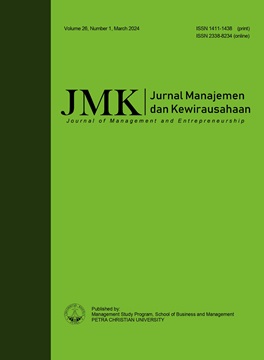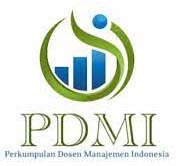IS COAL ABLE TO SHINE? THE ROLE OF LEGAM IN SUPPORTING COAL JEWELRY-BASED SOCIAL ENTREPRENEURSHIP
 :
:
https://doi.org/10.9744/jmk.26.1.34-45
Keywords:
Coal, Sawahlunto, Legam jewelry, social entrepreneurshipAbstract
As coal mining activities ceased in Sawahlunto, tourism, and the creative industry emerged as alternative avenues for the city's development. Legam is a player in the creative industry, specifically in the fashion sub-sector, specializing in coal-based jewelry production, a material abundant in Sawahlunto. Employing a narrative approach and conducting interview data collection, this research aimed to identify the role of Legam Jewelry in supporting social entrepreneurship. A social entrepreneurship approach served as the analytical framework, considering Legam Jewelry's unique business operations. Differences in the locations of raw material sources, workers' residences, and the business owner's domicile increased operational costs. It was interesting to comprehend Legam's motivation for maintaining this location difference between Bandung and Sawahlunto. The research findings indicated that Legam aligned its business processes with social entrepreneurship elements such as social value, civil society, innovation, and economic activities. Despite being deemed capable of fulfilling these social entrepreneurship elements, several critical points required attention in Legam's business processes. One such point related to the need for government support to facilitate physical exhibitions after the coronavirus disease (COVID-19) pandemic. In creating a massive social impact, efforts were necessary to encourage the emergence of similar entrepreneurs in Sawahlunto and other regions.
References
Arasti, Z., Zarei, H., & Didehvar, F. (2014). Iden-tifying the evaluative indicators of regulatory policies for the development of social en-trepreneurship. Public Organization Revi¬ew, 15(3), 453–474. https://doi.org/10.1007/s11115-014-0282-y
Armis, R., & Kanegae, H. (2020). The attractiveness of a post-mining city as a tourist destination from the perspective of visitors: A study of Sawahlunto old coal mining town in Indonesia. Asia-Pacific Journal of Regional Science, 4, 443–461. https://doi.org/10.100 7/s41685-019-00137-4
Armis, R., & Kanegae, H. (2021). Regional com-petitiveness of a post-mining city in tourism: Ombilin coal mining heritage of Sawahlunto, Indonesia. Regional Science Policy and Practice, 13(6), 1888–1910. https://doi.org/10.1111/rsp3.12404
Caetano, I. (2017). Innovation, evaluation and measurement: Macro-level and firm-level perspectives. In S. P. D. O. Monteiro & E. G. Carayannis (Eds.), The quadruple inno¬va¬tion helix nexus: A smart growth model, quantitative empirical validation and operationalization for OECD countries (pp. 173–210). Palgrave Macmillan. https://doi.org/10.1057/978-1-137-55577-9
Cheris, R., Repi, R., & Amalia, D. (2020). Sustainable conservation of the coal mining town: Ombilin Sawahlunto West Sumatra Indonesia context. IOP Conference Series: Earth and Environmental Science, 469, 012068. https://doi.org/10.1088/17551315/469/1/012068
Choi, N., & Majumdar, S. (2014). Social entrepreneurship as an essentially contested concept: Opening a new avenue for systematic future research. Journal of Business Venturing, 29(3), 363–376. https://doi.org/10.1016/j.jbusvent.2013.05.001
Erro-Garcés, A. (2020). Creativity and emotions as drivers for social entrepreneurship. Journal of Social Entrepreneurship, 11(3), 300–316. https://doi.org/10.1080/19420676.2019.1640773
Fitriani, S., Wahjusaputri, S., & Diponegoro, A. (2021). The collaborated trade shows and community entrepreneurs: How they benefit small medium-sized enterprises. Jurnal Manajemen dan Kewirausahaan, 23(1), 84–93. https://doi.org/10.9744/jmk.23.1.84
García-Jurado, A., Pérez-Barea, J. J., & Nova, R. J. (2021). A new approach to social entrepreneurship: A systematic review and meta-analysis. Sustainability, 13(5), 2754. https://doi.org/10.3390/su13052754
Germak, A. J., & Robinson, J. A. (2014). Exploring the motivation of nascent social entrepreneurs. Journal of Social Entrepreneurship, 5(1), 5–21. https://doi.org/10.1080/19 420676.2013.820781
González-Benito, Ó., Muñoz-Gallego, P. A., & García-Zamora, E. (2016). Role of collaboration in innovation success: Differences for large and small businesses. Journal of Business Economics and Management, 17(4), 645–662. https://doi.org/10.3846/16111699. 2013.823103
Gregory, D., Low, P., Septiani, D. I., Talukdar, S., Ace, T., Ramadhita, S., Indasari, P. M., & Amorita, G. (2020). Creative and social enterprise in Indonesia. Retrieved from https://www.britishcouncil.id/sites/default/files/dice_creative_and_social_enterprise_in_indonesia_report_en_final.pdf
Hulgard, L. (2010). Discourses of social entrepreneurship: Variations of the same theme? EMES European Research Network, 10, 1–21.
Kahn, K. B. (2018). Understanding innovation. Business Horizons, 61(3), 453–460. https://doi.org/10.1016/j.bushor.2018.01.011
Kementerian Perindustrian Republik Indonesia. (2022). Ekspor naik 76 persen, kemenperin fasilitasi IKM perhiasan tembus pasar global. Retrieved from https://kemenperin.go.id/artikel/ 23471/Ekspor-Naik-76-Persen,-Kemenperin-Fasilitasi-IKM-Perhiasan-Tembus-Pasar-Global-
Klein, M., Gutowski, P., Gerlitz, L., & Gutowska, E. (2021). Creative and culture industry in Baltic sea region condition and future. Sustainability, 13(8), 1–17. https://doi.org/10.3390/su13084239
Klein, M., & Spychalska-Wojtkiewicz, M. (2020). Cross-sector partnerships for innovation and growth: Can creative industries support traditional sector innovations? Sustainability, 12(23), 10122. https://doi.org/10.3390/su122310122
Lepoutre, J., Justo, R., Terjesen, S., & Bosma, N. (2013). Designing a global standardized methodology for measuring social entrepreneurship activity: The global entrepreneurship monitor social entrepreneurship study. Small Business Economics, 40, 693–714. https://doi.org/10.1007/s11187-011-9398-4
Littlewood, D., & Holt, D. (2018). Social entrepreneurship in South Africa: Exploring the influence of environment. Business and Society, 57(3), 525–561. https://doi.org/10.1177/000765031561 3293
Luke, B., & Chu, V. (2013). Social enterprise versus social entrepreneurship: An examination of the “why” and “how” in pursuing social change. International Small Business Journal: Researching Entrepreneurship, 31(7), 764–784. https://doi.org/10.1177/0266242612462598
Mair, J., & Martí, I. (2006). Social entrepreneurship research: A source of explanation, prediction, and delight. Journal of World Business, 41(1), 36–44. https://doi.org/10.1016/j.jwb.2005.09.002
Mitchell, I. K., & Walinga, J. (2017). The creative imperative: The role of creativity, creative problem solving and insight as key drivers for sustainability. Journal of Cleaner Pro¬duction, 140(3), 1872–1884. https://doi.org/10.1016/j.jclepro.2016.09.162
Napsiah. (2019). Sosialisasi kewirausahaan sosial di perguruan tinggi Islam. Jurnal Psikologi Integratif, 7(2), 153–170. https://doi.org/10.14421/jpsi.v7i2.1844
Okpara, J. O., & Halkias, D. (2011). Social entrepreneurship: An overview of its theoretical evolution and proposed research model. International Journal of Social Entrepreneurship and Innovation, 1(1), 4–20. https://doi.org/10.1504/ijsei.2011.039808
Puumalainen, K., Sjögrén, H., Syrjä, P., & Barraket, J. (2015). Comparing social entrepreneurship across nations: An exploratory study of institutional effects. Canadian Journal of Administrative Sciences, 32(4), 276–287. https://doi.org/10.1002/cjas.1356
Ratten, V. (2020). Coronavirus (COVID-19) and social value co-creation. International Journal of Sociology and Social Policy, 42(3–4), 222–231. https://doi.org/10.1108/IJSSP-06-2020-0237
Renjana. (2017). Peran perempuan melalui kewirausahaan sosial dalam pemberdayaan perempuan. Jurnal ISIP: Jurnal Ilmu Sosial dan Ilmu Politik, 14(2), 13–25.
Rey-Martí, A., Ribeiro-Soriano, D., & Palacios-Marqués, D. (2016). A bibliometric analysis of social entrepreneurship. Journal of Business Research, 69(5), 1651–1655. https://doi.org/10.1016/j.jbusres. 2015.10.033
Saebi, T., Foss, N. J., & Linder, S. (2019). Social entrepreneurship research: Past achievements and future promises. Journal of Management, 45(1), 70–95. https://doi.org/10.1177/014920631 8793196
Shi, A., Huo, F., & Hou, G. (2021). Effects of design aesthetics on the perceived value of a product. Frontiers in Psychology, 12, 670 800. https://doi.org/10.3389/fpsyg.2021.67 0800
Silina, Y., & Haddadi, H. (2015). New directions in jewelry: A close look at emerging trends & developments in jewelry-like wearable de-vices. ISWC '15: Proceedings of the 2015 ACM International Symposium on Wearable Computers, 49–56. https://doi.org/10.1145/2802083.2808410
Statista (2023). Jewelry - Indonesia. Retrieved from https://www.statista.com/outlook/cmo/accessories/watches-jewelry/jewelry/indonesia
Syafrini, D., Nurdin, M. F., Sugandi, Y. S., & Miko, A. (2021). Transformation of a coal mining city into a cultured mining heritage tourism city in Sawahlunto, Indonesia: A response to the threat of becoming a ghost town. Tourism Planning and Development, 0(0), 1–20. https://doi.org/10.1080/21568316.2020.1866653
Urban, B., & Kujinga, L. (2017). The institutional environment and social entrepreneurship intentions. International Journal of Entrepreneurial Behaviour and Research, 23(4), 638 –655. https://doi.org/10.1108/IJEBR-07-2016-0218
Utomo, H. (2014). Menumbuhkan minat kewirausahaan sosial. Among Makarti, 7(2), 1–16. http://dx.doi.org/10.52353/ama.v7i2.99
Versteeg, M., van den Hoven, E., & Hummels, C. (2016). Interactive jewellery: A design exploration. Proceedings of the TEI '16: Tenth International Conference on Tangible, Embedded, and Embodied Interaction, 44–52. http://dx.doi.org/10.1145/2839462.2839504
Wahyuni, S., & Khaidir, A. (2020). Implementasi strategi dinas pariwisata pemuda dan olahraga dalam mengembangkan ekonomi kreatif di kota Sawahlunto. Jurnal Manajemen dan Ilmu Administrasi Publik, 2(4), 20–27. https://doi.org/10.24036/jmiap.v2i4.173
Yuniantari, R., & Harini, R. (2021). Economic valuation of coal mine reclamation Kandih, Sa-wahlunto Regency, West Sumatera. IOP Conference Series: Earth and Environmental Science, 683, 012089. https://doi.org/10.1088/1755-1315/683/1/012089
Zaato, S. G., Ismail, M., Uthamaputhran, S., & Owusu-Ansah, W. (2020). The impact of entrepreneurial orientation on SMEs performance in Ghana: The role of social capital and governmenr support policies. Jurnal Manajemen dan Kewirausahaan, 22(2), 99–114. https://doi.org/10.9744/jmk.22.2.99-114
Zainea, L. N., Toma, S.-G., Marinescu, P., & Chi-țimiea, A. (2020). Combating unemployment through social entrepreneurship in the european context. Business Ethics and Lea-dership, 4(4), 85–98. https://doi.org/10.21272/bel.4(4).85-98.2020
Downloads
Published
How to Cite
Issue
Section
License
Copyright (c) 2024 Rakhman Priyatmoko, Addin Maulana, Dini Oktaviyanti, Yessy Febrina Usman, Fauziah Khoiriyani

This work is licensed under a Creative Commons Attribution 4.0 International License.
Authors who publish on this journal agree to the following terms:
- Authors retain copyright and grant the journal right of first publication with the work simultaneously licensed under a Creative Commons Attribution License that allows others to share the work with an acknowledgement of the work's authorship and initial publication in this journal.
- Authors are able to enter into separate, additional contractual arrangements for the non-exclusive distribution of the journal's published version of the work (e.g., post it to an institutional repository or publish it in a book), with an acknowledgement of its initial publication in this journal.
- Authors are permitted and encouraged to post their work online (e.g., in institutional repositories or on their website) prior to and during the submission process, as it can lead to productive exchanges, as well as earlier and greater citation of published work (See The Effect of Open Access).


















